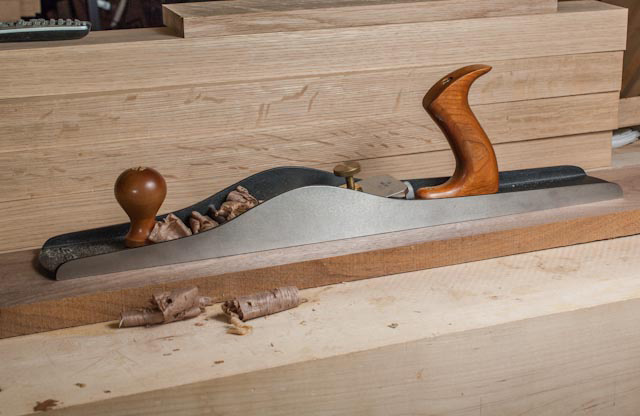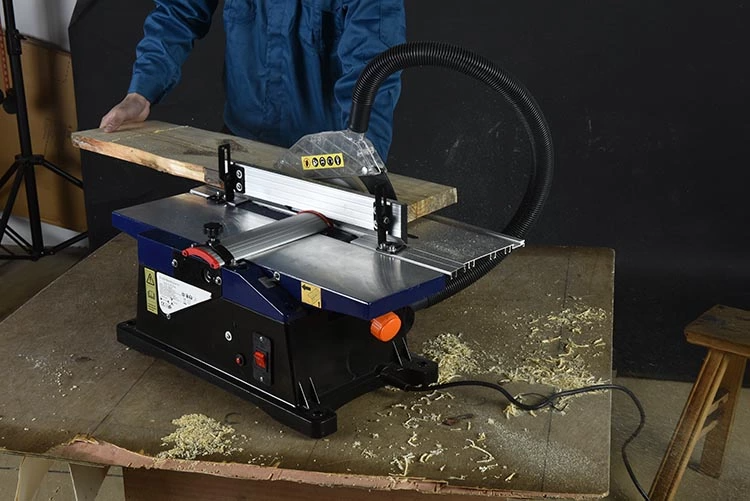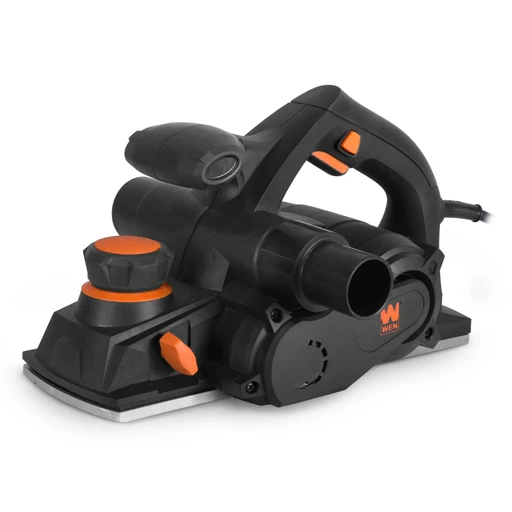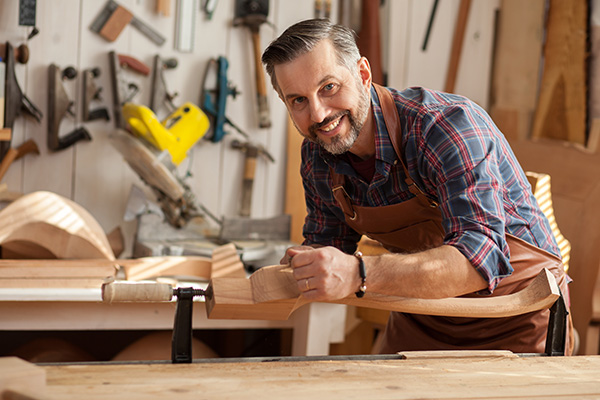All wood crafters own wood planers. Period.
There are numerous ways you can finish a wood project. Whether that is by adding texture, design, engravings, or just good old paint and lacquer. However, to make these finishes really pop you need to have the right surface to lay them on.
Planers come in a lot of different styles since there are so many different situations where wood needs to be smoothed out. In this article, we cover everything you need to know about the types of planers, their application, the different brands and models available, and many other aspects you will want to keep in mind before investing in your first, or your next, planer.
Let’s dive in!
1. What Is A Wood Planer Machine?

To get a professional finish to your wood projects, you need to plain your wood to get the right visual and structural results.
This finish can be achieved through tools when you trim and plane your wood.
The wood planer is one of the tools that helps you resize your wooden boards. It sharpens your wood boards, makes their thickness right, or flattens the surfaces to prepare the right material for your woodwork projects.
You can call it a surface planer.
Let me explain its usage a bit more so that you can define your needs more clearly before getting one for yourself.
2. What Does A Planer Do To Wood?

A wooden block with rough edges and an uneven surface can not serve you for your wood projects at all.
All you need to do is get your hands on a power wood planer to shape perfect construction blocks for your project.
Wood planers are available in different sizes and weights to accommodate the workspace and nature of work.
Imagine scraping butter off a butter block with a knife. In principle, that is similar to what a wood planer does with woodblocks.
The types and jobs of wood planers vary. But most commonly, a planer can
- Smooth the surface of the wood
- Trim the thickness of the wood
- Square the wood
Wood planers are supported with powerful motors that allow a one-pass transformation.
Larger wood planers primarily consist of a cutter head with cutting knives, a roller for drawing the wood board through the machine, and a table that can control the board’s thickness.
Portable and handheld wood planers not only differ in their construction but also in their job.
3. How Do You Use A Wood Planer?

A power wood planer is an excellent option to trim your boards evenly as compared to a hand wood planer.
To finish your board more uniformly, make sure that you put the board correctly in the power wood planer.
Wood planers are easy to use and can prepare material for the project in no time.
- Create a reference face of the board that should be laid flat on the wood planer’s table.
- The moment the board is in contact with the in-feed roller, it will grip it to draw the board through the cutter.
- The cutter head will clear the rough surface of the opposite side.
- The outfeed roller will help the board to eject.
A reference face can be made with the first pass-through or from a jointer.
Caution: Keep the lower face surface flat. The feed roller pressure can deform the board if it’s not flat.
4. What Are The Different Types Of Wood Planers?
It can be tricky to find the right planer for the job.
In this section, we will discuss the 5 major types of wood planers. This will give you a better idea about what each type of planer is best suited to and what will be the right choice for your project.
i. Manual Hand Wood Planers

These types of wood planers are made for manual use. They are comparatively smaller and portable.
Hand wood planers are available in multiple formats including block planers, smooth planers, jack planers, etc. They are good portable wood planers.
Why are they worth buying?
- They are less costly
- They are not noisy
- They may help you flatten the surface in areas that a powered planer can’t reach.
- They are portable
ii. Electric Hand Wood Planer

These wood planers also fall in the portable and compact class. They are handheld, yet they are powered by cords or batteries.
These portable wood planers are more commonly used as they are great time savers.
There are two types of electric-powered handheld wood planers: straight and curved.
Straight planers are mostly used to shape the wood and smooth the surfaces. They are suitable for carpenters, home manufacturers, and also for homeowners.
Whereas the curved planers are designed to shape the wood into arches, arcs, and other curved surfaces.
Why are they worth buying?
- They are fast in performance
- They are portable
- They are more practical in their functions
- Versatile functionality with wider cutting heads
iii. Benchtop Wood Planers

A wood planing machine that rests on the benchtop to plane your wood boards is a benchtop wood planer.
It planes the wood and adjusts its thickness, and with its 6-inch wide cutting head, it allows different lengths and widths to go through. The tabletop planer is lightweight as compared to the stationary planer.
Why are they worth buying?
- They are good for shorter and thinner boards.
- They are more budget-friendly than stationary planers.
- They are lightweight and easy to manage.
iv. Stationary Wood Planers

These planers are mostly used for professional-grade work.
These are bigger and heavier as compared to tabletop planers. They can do the job without a benchtop position.
Stationary planers are more powerful and fast in their performance.
Their wider cutter heads allow them to deal with a variety of wood lengths and widths.
It can be more expensive than the other options discussed before.
Why are they worth buying?
- They can handle various lengths and widths.
- They are faster and more powerful in operation.
- They are more suitable to meet professional needs.
v. 2 in 1 Planer

2-in-1 planers perform multiple functions. This machine can be your planer as well as a woodcraft jointer or a molder too.
This makes it more cost-effective and also eliminates the hassle of having to switch between two different tools. You also save money in the form of lower energy costs and the cost of maintaining the two tools.
Jointer helps in squaring the boards.
Molder helps in molding the thickness.
Why are they worth buying?
- They are good for saving money, energy, and time.
- They are more functional.
- They can create a perfect material for any woodwork job.
- They are equally suitable for professionals as well as homeowners.
5. Are wood planners worth it?
Do you think you can go for your next DIY project or professional work without actually trimming your wood?
If not, then you definitely need a thickness planer.
A door in your living room may be stubborn and won’t open smoothly. How are you going to fix that?
Yes, it can be a wood planer that can ease a concerned homeowner’s job or help the professional glue some smooth and well-trimmed planks to make a woodwork job look perfect.
Our research on a variety of wood planers and their details will help you buy one that meets your work demands.
Also, keep in mind that sanding down surfaces is also a big part of finishing wood projects and achieving the look you want. Planers will give you the right surface to get started with a project but with the right sander, you can really finalize and optimize the finished product. We have put together a comprehensive guide on sanders which will really help you understand how to make the most of those products. So have a look at that right now, or save it for later!
6. What Should I Look For In A Planner?

Before buying a powered wood planer, I would recommend considering some factors that can add real value to your purchase.
The knowledge of a product can help you buy the most suitable option and get the most band for your buck.
So, let’s look at some of the most important factors you should consider before buying a powered planer.
i. Cost
I know the most important factor is the cost of buying any product. There are plenty of products at drastically different price points when it comes to planers. However, buying the most expensive option wont guarantee the best performance, and buying the cheapest option might save you money upfront but will cost you more in the longrun.
Most good-quality wood planers are also backed up with a warranty. Warranties, quality functional parts, and ergonomic constructional designs add to the worth of a product by allowing a top-notch performance.
Moreover, you also want to look into the the maintenance cost of a product. So consider these things when looking for a tool. Buy a user-friendly, low-maintenance wood planer.
ii. Motor Power
The first and foremost factor that will affect your wood trimming experience is the motor’s power rating.
There are a variety of power motors dedicated to the planers. Other than size, the nature of the job also determines the power of the motor.
Mostly 5 to 6 amp power is considered good by indoor woodworkers. Yet you can add more if you need to work on larger projects at the larger workplace.
iii. Feed Rate
Feed per Minute is the rate at which the wood moves through the machine and comes through the other side as a planed piece of timber. Naturally, if you are looking to work through a lot of wood you want a high feed rate. Also, when getting a beginner or budget-friendly option the feed rate is usually much slower than bigger, more expensive machines.
iv. Some Other Essential Parts

A few more aspects of the planer you want to look at include the following:
Blades
Carbide blades are more durable, and they also deliver better results as compared to HSS. Blades will determine the cutting depth and the bed width also add into the form.
So, to get the desired results, set your bed/table properly, and adjust the width according to the wood board as this is crucial to achieve the right trim.
Cord
You can also consider the length of the cord according to your work area.
Longer cords are better as they have a good reach. If you need to transport your tool more often, winding a long cord can be a hassle. So always consider it according to your needs. Alternatively, you can always opt for a cordless planner, they are increasingly more popular.
Chip
In order to make your tool more versatile and convenient, check the location of the chip. Left or right locations are more functional which allows greater ease of use.
v. User-friendliness
While selecting a wood planer, keep the complexities of its operations and other functions in mind. Try to find a user-friendly wood surface planer that can be easy for you and fulfill your needs.
vi. Efficiency
Do you think the efficiency of a tool depends upon its speed only?
Let me clear this myth.
The efficiency of a tool is completing a task within the required time with all its desired finish.
So if your surface planer has power, sharp accessories, and appropriate construction design, you have reached the right tool.
vii. Safety

Your safety is a top priority.
So, keep all the safety measures in mind before buying and even while using the wood planer.
- Read the manual instructions carefully before installation and/or operation.
- Install the surface planer at a safe place so that you can keep children and pets away from it.
- Always check the cord properly before switching on the wood planer.
- Always use a dust mask, goggles, and earplugs while operating wood planers to avoid any serious harm or injury.
- Don’t put wood blocks/planks into the machine until the blades are at the highest position.
- It’s preferable to use a push blocker.
- Never leave a wood planer or jointer unattended.
- Never exceed the limited capacity of the wood planer by putting an oversized piece of wood.
- Maintain your tool timely and clean beforehand after every use so that particles or any other liter don’t hinder its safety and performance.
- Keep the dust bags and other accessories clean.
- Avoid any contact with the moving parts while operating.
- Avoid wearing loose-fitting clothes at the workplace and also tie back your hair or any other accessories.
- Unplug the tool after each use.
7. Some Top Brands For Wood Planers
We certainly recommend buying a planer from a well-reputed manufacturer. You will be paying a premium but it will be well worth it in terms of the longevity, durability, performance, and safety of the machine. Here are some of the top brands.
i. DEWALT

DEWALT is a reliable name in the tools industry. Year after year, they have maintained their top spot by delivering durable and top-performing tools.
As far as the wood planers are concerned, DEWALT manufactures some of the best. Variable speed with a wide base and sharp yet durable cutting blade make the DEWALT wood planers outstanding.
Moreover, they offer quiet and constant operation for the perfect results.
User-friendly quality with well-made construction is applied to all the tools made by DEWALT.
Their bench planer may cost comparatively more, but their quality is worth that price.
ii. WEN

This brand is going to offer a fast feed rate that is remarkable, along with other functional features.
WEN is a preferable brand by many professionals as it is not only delivering durable top-performing tools but also several budget-friendly options.
Fine cutting blades with tune depth adjustments, the thickness planer by WEN helps you create a perfect finish to your boards.
Most of WEN’s models are made to deal with raw stock, so if you mostly deal with raw stock, WEN is your true mate being a budget planer too.
Also, check out their bench planers!
iii. Matika

Matika is known for its compact designs and sleek looks.
Its wood planers are lightweight and a great pick if portability is a priority.
Matika planers are quiet and smooth in operation. These wood planers are good in their speed and planning. The only thing not allowing it a higher spot is their high prices.
Lumber planers by Matika are good products with fast speed and variable adjustments if you have the budget for it.
iv. Porter

Another reliable name among the tool makers. Many professionals like the portability and build quality of the Porter tools.
The surface planer by Porter is made with dual dust extensions that help them achieve smooth planning.
Moreover, it’s the most convenient tool made by Porter. It’s lightweight, and its depth adjustment qualities make it perfect in terms of performance.
They are good as a budget planer.
v. Grizzly

Grizzly is making its place among tool manufacturers. Its best features for wood planers include its fast feeding speed and perfect planning output. Though it has hardly a three-blade cutting head yet, it’s marking its name high by an impressive performance.
It’s also made lightweight and easy to transport. Its accuracy in work is not matchable.
Its bench planer falls in the range of low-priced products that you can easily afford.
vi. Delta

Delta is another attractive option in wood planers. It has three knives and a cutter lock that can provide peace of mind while working with your wood planer.
To some extent, it can cause maintenance problems. Other than that, their good speed and feeding rate can finish the wood more precisely.
Delta has been in the business for more than 90 years. It provides attractive warranties and powerful performance tools.
Wood planers by Delta are perfect for casual use.
8. Essential Features of Wood Planers

Wood planers are given some outstanding features so that you can create a perfectly smooth material for your upcoming woodwork job.
Let’s check the features in detail to know the right features before you buy it.
i. Thickness
Whether it’s your workshop or home where you are going to use your wood planer, it should be easy to handle and serve the purpose well.
Handheld wood planers can also make the surface of the board smooth and even. But it can take more time and energy to reach perfection. If the board is not straight and you are working on its thickness, it may not give you the desired results.
So, an electric wood planer is more appropriate for making the surface even, trimming the board, and cutting it into a square shape.
There are various types and sizes of the thickness planer that can be bought according to the nature of the job.
Yet the most commonly used wood planers are electric hand-held wood planers and benchtop wood planers.
Stationary wood planers can also be a good option for professionals. The rest of the types are more expensive and serve well for larger projects.
ii. Cutting Depth
The purpose of buying a wood planer is to cut the wood properly to an even shape, so it depends on how raw your stock is.
If you need to clear your wooden boards to a certain roughness level, you may have to pass it through many times to get the required result.
So cutting depth can tell you how many passes you need to get a clear and formed material to achieve a smoother wood.
Many of the wood planers offer cutting depth 1/16th of an inch at a time. You can also find a wood surface planer with a 3/32nd inch to complete the job in fewer passes.
But be careful while selecting a wood surface planer according to cutting depth if you are dealing with softwood and delicate work. Deep cutting can cause tear-outs or ruin your material instantly.
So, in this case, you can opt for a shallow-cutting planer with more passes to reach the desired result.
iii. Dust Collection
Many high-end wood planers offer dust collection facilities that lead to a cleaner work area and top performance with a clear tool bed.
Benchtop wood planers are mostly added with dust collection ability. 2 ½ inches to 4 inches dust ports are designed to collect dust more easily.
You can also add a converter to attach to the dust port to collect dust efficiently. Small portable wood planers lack this feature.
9. Conclusion

Be it a home planer or a professional aid woodcraft jointer, invest in the right option.
Armed with this knowledge you can confidently go out and evaluate different kinds of planers depending on your needs. We highly recommend physically inspecting planers before you buy one so you have a better idea of the size, weight, and capability of the planer.
- How to Choose the Perfect Exterior Paint for Your Wood Siding - October 18, 2023
- Definitive Guide to Wood Planers: Everything You Need to Know - October 8, 2023
- The Definitive Guide to Wood Sanders: Types, Uses and Comparisons - October 5, 2023

